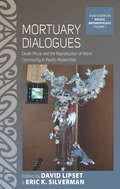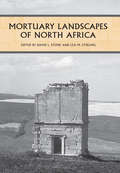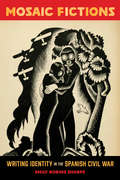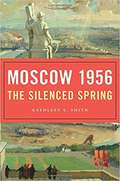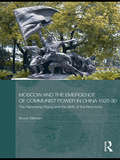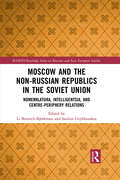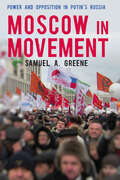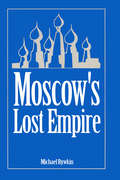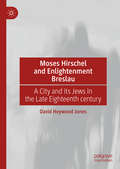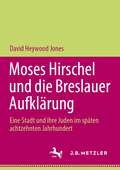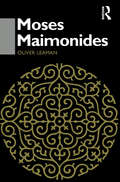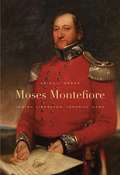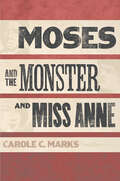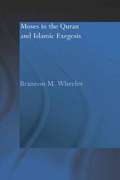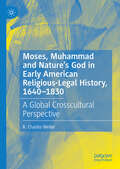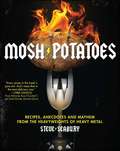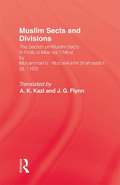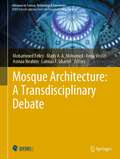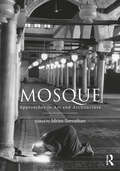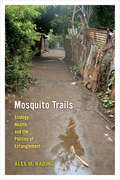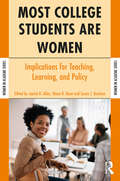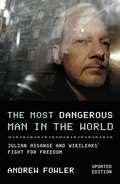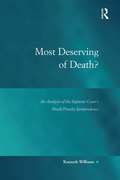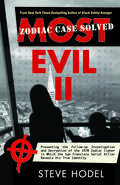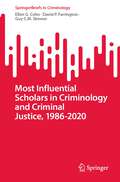- Table View
- List View
Mortuary Dialogues: Death Ritual and the Reproduction of Moral Community in Pacific Modernities (ASAO Studies in Pacific Anthropology #7)
by David Lipset Eric K. SilvermanMortuary Dialogues presents fresh perspectives on death and mourning across the Pacific Islands. Through a set of rich ethnographies, the book examines how funerals and death rituals give rise to discourse and debate about sustaining moral personhood and community amid modernity and its enormous transformations. The book's key concept, "mortuary dialogue," describes the different genres of talk and expressive culture through which people struggle to restore individual and collective order in the aftermath of death in the contemporary Pacific.
Mortuary Landscapes of North Africa
by David L. Stone Lea StirlingCemetery and landscape studies have been hallmarks of North African archaeology for more than one hundred years. Mortuary Landscapes of North Africa is the first book to combine these two fields by considering North African cemeteries within the context of their wider landscapes. This unique perspective allows for new interpretations of notions of identity, community, imperial influence, and sacred space. Based on a wealth of material research from current fieldwork, this collection of essays investigates how North African funerary monuments acted as regional boundaries, markers of identity and status, and barometers of cultural change. The essays cover a broad range in terms of space and time - from southern Libya to eastern Algeria, and from the seventh century BCE to the seventh century CE. A comprehensive introduction explains the importance of the 'landscape perspective' that these studies bring to North African funerary monuments, while individual case-studies address such topics as the African way of death among the Garamantes, the ritual reasons for the location of certain Early Christian tombs, Punic burials, Roman cupula tombs, and the effects of rapid state formation and imperial incorporation on tomb builders. Unique in both scope and perspective, this volume will prove invaluable to a cross-section of archaeological scholars.
Mosaic Fictions: Writing Identity in the Spanish Civil War
by Emily Robins SharpeMosaic Fictions is the first book-length critical analysis of Canadian Spanish Civil War literature. Treating published and archival writings, the book focuses on the extensive contributions of Jewish Canadian authors as they articulate the stakes of the Spanish Civil War (1936–39) in the language of a nascent North American multiculturalism. Placing Jewish Canadian writers within overlapping North American networks of Jewish, Black, immigrant, female, and queer writers challenges the national distinctions that dominate current critical approaches to Anglophone Spanish Civil War literature. Reframing the narrative of Spain’s noble but tragic struggle against fascism in the Spanish Civil War, the book demonstrates how marginalized North American supporters of the Spanish Republic crafted narratives of inclusive citizenship amidst a national crisis not entirely their own. Mosaic Fictions examines texts composed between the war’s outbreak and the present to illuminate the integral connections between Canada’s developing national identity and global leftist action.
Moscow 1956: The Silenced Spring
by Kathleen E. SmithIn 1956 Khrushchev stunned Communists by reciting a litany of Stalin’s abuses. His bid to rejuvenate the Party opened the door to upheaval, as Soviet citizens asked where the system had gone astray. Kathleen Smith contends that the year’s brief thaw set in motion a cycle of reform and retrenchment that would recur until the Soviet Union’s collapse.
Moscow and the Emergence of Communist Power in China, 1925-30: The Nanchang Uprising and the Birth of the Red Army (Routledge Studies in the Modern History of Asia)
by Bruce EllemanThis book examines the emergence of Communist power in China during the interwar period, focusing especially on the role of the Soviet Union and the 1927 Nanchang Uprising. It describes the history behind the alliance between the Chinese Communists and Nationalists, the impact of the USSR's military and political advisers, and the success of the Northern Expedition that resulted in the April 1927 purge of the Communists from the Nationalist Party. It explores the debates between leading communists in Moscow, notably Stalin – who thought that China was ready in 1927 for an urban-based Communist revolution, similar to what had happened in Russia ten years before – and Trotsky who opposed it. It goes on examine the seizure of power in Nanchang by the Communists, the establishment of China's first short-lived soviet republic, and the reasons why the soviet soon collapsed. It explains the consequences of the rising, including the adoption by the Communists of guerilla warfare, the foundation of China's second soviet, and after moving to northwest China during the 1930s, the rise of Communist power throughout all of mainland China which culminated in the establishment of the People’s Republic of China in 1949. The book stresses the importance of the mythology that evolved around the Nanchang Uprising: since criticism of the Nanchang Uprising would open themselves up to accusations that they were Trotskyites, the Chinese Communists created the myth that the Nanchang Uprising was a success, and later dated the origins of the People’s Liberation Army to this event.
Moscow and the Non-Russian Republics in the Soviet Union: Nomenklatura, Intelligentsia and Centre-Periphery Relations (BASEES/Routledge Series on Russian and East European Studies)
by Li Bennich-BjörkmanThis book examines what came to determine the local power and character of the Communist party-state at the level of the national non-Russian republics. It discusses how, although the Soviet Union looked centralised and monolithic to outsiders, local party-states formed their own fiefdoms and had very considerable influence over many policies areas within their republics. It argues that local party-states were shaped by two decisive relationships - to the central Communist party in Moscow and to local constituencies, especially to the local intelligentsia and the creative professions who constituted the local party-states’ biggest potential adversaries. It shows how local party-states negotiated stability and their own survival, and contends that the effects of "Sovietisation" continue to be felt in the independent states which succeeded the republics, particularly in the field of the relationship with Moscow, which remains of immense importance to these countries.
Moscow in Movement: Power and Opposition in Putin's Russia
by Samuel A. GreeneMoscow in Movement is the first exhaustive study of social movements, protest, and the state-society relationship in Vladimir Putin's Russia. Beginning in 2005 and running through the summer of 2013, the book traces the evolution of the relationship between citizens and their state through a series of in-depth case studies, explaining how Russians mobilized to defend human and civil rights, the environment, and individual and group interests: a process that culminated in the dramatic election protests of 2011–2012 and their aftermath. To understand where this surprising mobilization came from, and what it might mean for Russia's political future, the author looks beyond blanket arguments about the impact of low levels of trust, the weight of the Soviet legacy, or authoritarian repression, and finds an active and boisterous citizenry that nevertheless struggles to gain traction against a ruling elite that would prefer to ignore them. On a broader level, the core argument of this volume is that political elites, by structuring the political arena, exert a decisive influence on the patterns of collective behavior that make up civil society—and the author seeks to test this theory by applying it to observable facts in historical and comparative perspective. Moscow in Movement will be of interest to anyone looking for a bottom-up, citizens' eye view of recent Russian history, and especially to scholars and students of contemporary Russian politics and society, comparative politics, and sociology.
Moscow's Lost Empire
by Michael RywkinThis volume gives an overview of the regional, ethnic and political structure of the Soviet empire from its establishment through its ultimate disintegration. It provides a corrective to the Russocentrism and Great Power bias that has marked most studies of the Soviet Union.
Moses Hirschel and Enlightenment Breslau: A City and its Jews in the Late Eighteenth Century
by David Heywood JonesBreslau has been almost entirely forgotten in the Anglophone sphere as a place of Enlightenment. Moreover, in the context of the Jewish Enlightenment, Breslau has never been discussed as a place of intercultural exchange between German-speaking Jewish, Protestant and Catholic intellectuals. An intellectual biography of Moses Hirschel offers an excellent case-study to investigate the complex reciprocal relationship between Jewish and non-Jewish enlighteners in a prosperous and influential Central European city at the turn of the 18th century.
Moses Hirschel und die Breslauer Aufklärung: Eine Stadt und ihre Juden im späten achtzehnten Jahrhundert
by David Heywood JonesBreslau ist im englischsprachigen Raum als Ort der Aufklärung fast völlig in Vergessenheit geraten. Darüber hinaus ist Breslau im Kontext der jüdischen Aufklärung nie als Ort des interkulturellen Austauschs zwischen deutschsprachigen jüdischen, protestantischen und katholischen Intellektuellen diskutiert worden. Eine intellektuelle Biographie von Moses Hirschel bietet ein hervorragendes Fallbeispiel, um die komplexen wechselseitigen Beziehungen zwischen jüdischen und nichtjüdischen Aufklärern in einer wohlhabenden und einflussreichen mitteleuropäischen Stadt an der Wende zum 18. Jahrhundert zu untersuchen.Die Übersetzung aus dem Englischen wurde mit Hilfe von künstlicher Intelligenz (anhand einer maschinellen Übersetzung durch einen Service von DeepL.com) angefertigt. Der Autor hat den Text durchgesehen, um die inhaltliche Richtigkeit des Werkes zu prüfen und gegebenenfalls Anpassungen vorzunehmen.
Moses Maimonides (Routledge Jewish Studies Series)
by Oliver LeamanMoses Maimonides (1135--1204) is recognized both as a leading Jewish thinker and as one of the most radical philosophers of the Islamic world. The study reveals the significance of Maimonides to contemporary philosophical and theological problems.
Moses Montefiore
by Abigail GreenHumanitarian, philanthropist, and campaigner for Jewish emancipation on a grand scale, Sir Moses Montefiore (1784-1885) was the preeminent Jewish figure of the nineteenth century-and one of the first truly global celebrities. His story, told here in full for the first time, is a remarkable and illuminating tale of diplomacy and adventure. Abigail Green's sweeping biography follows Montefiore through the realms of court and ghetto, tsar and sultan, synagogue and stock exchange. Interweaving the public triumph of Montefiore's foreign missions with the private tragedy of his childless marriage, this book brings the diversity of nineteenth-century Jewry brilliantly to life-from London to Jerusalem, Rome to St. Petersburg, Morocco to Istanbul. Here we see the origins of Zionism and the rise of international Jewish consciousness, the faltering birth of international human rights, and the making of the modern Middle East. With the globalization and mobilization of religious identities now at the top of the political agenda, Montefiore's life story is relevant as never before. Mining materials from eleven countries in nine languages, Green's masterly biography bridges the East-West divide in modern Jewish history, presenting the transformation of Jewish life in Europe, the Middle East, and the New World as part of a single global phenomenon. As it reestablishes Montefiore's status as a major historical player, it also restores a significant chapter to the history of our modern world.
Moses and the Monster and Miss Anne
by Carole C. MarksThis engaging history presents the extraordinary lives of Patty Cannon, Anna Ella Carroll, and Harriet Tubman, three "dangerous" women who grew up in early-nineteenth-century Maryland and were vigorously enmeshed in the social and political maelstrom of antebellum America. The "monstrous" Patty Cannon was a reputed thief, murderer, and leader of a ruthless gang who kidnapped free blacks and sold them back into slavery, whereas Miss Anna Ella Carroll, a relatively genteel unmarried slaveholder, foisted herself into state and national politics by exerting influence on legislators and conspiring with Governor Thomas Holliday Hicks to keep Maryland in the Union when many state legislators clamored to join the Confederacy. And, of course, Harriet Tubman--slave rescuer, abolitionist, and later women's suffragist--was both hailed as "the Moses of her people" and hunted as an outlaw with a price on her head worth at least ten thousand dollars. All three women lived for a time in close proximity on the Eastern Shore of Maryland, an isolated region that thrived on tobacco and then lost it, procured slaves and then lost them, and produced strong-minded women and then condemned them. Though they never actually met, and their backgrounds and beliefs differed drastically, these women's lives converged through their active experiences of the conflict over slavery in Maryland and beyond, the uncertainties of economic transformation, the struggles in the legal foundation of slavery and, most of all, the growing dispute in gender relations in America. Throughout this book, Carole C. Marks gleans historical fact and sociological insight from the persistent myths and exaggerations that color the women's legacies, and she investigates the common roots and motivations of three remarkable figures who bucked the era's expectations for women. She also considers how each woman's public identity reflected changing ideas of domesticity and the public sphere, spirituality, and legal rights and limitations. Cannon, Carroll, and Tubman, each in her own way, passionately fought for the future of Maryland and the United States, and from these unique vantage points, Moses and the Monster and Miss Anne portrays the intersecting and conflicting forces of race, economics, and gender that threatened to rend a nation apart.
Moses in the Qur'an and Islamic Exegesis (Routledge Studies in the Qur'an)
by Brannon M. WheelerRelating the Muslim understanding of Moses in the Qur'an to the Epic of Gilgamesh, Alexander Romances, Aramaic Targums, Rabbinic Bible exegesis, and folklore from the ancient and medieval Mediterranean, this book shows how Muslim scholars authorize and identify themselves through allusions to the Bible and Jewish tradition. Exegesis of Qur'an 18:60-82 shows how Muslim exegetes engage Biblical theology through interpretation of the ancient Israelites, their prophets, and their Torah. This Muslim use of a scripture shared with Jews and Christians suggests fresh perspectives for the history of religions, Biblical studies, cultural studies, and Jewish-Arabic studies.
Moses, Muhammad and Nature’s God in Early American Religious-Legal History, 1640-1830: A Global Crosscultural Perspective
by R. Charles WellerThis is the first comparative study of Mosaic and Islamic law in American history to be published. Constructing a complex picture in trans-Atlantic, trans-European and world historical perspectives, this book elucidates the intersections that lie beneath and behind the rise of the debates in the 1990s and 2000s over the promotion of the Ten Commandments and Mosaic Law as alleged sources of American Constitutional law and symbols of American national identity. These debates have taken shape in close connection with resurgent anti-Semitism, anti-Sharia protests and anti-Sharia legislation throughout the United States and other Western societies.
Mosh Potatoes
by Steve SeaburyDivided into "Opening Acts" (appetizers), "Headliners" (entrees), and "Encores" (desserts), Mosh Potatoes features 147 recipes that every rock 'n' roll fan will want to devour--including some super-charged Spicy Turkey Vegetable Chipotle Chili from Ron Thal of Guns N' Roses, Orange Tequila Shrimp from Joey Belladonna of Anthrax (complete with margarita instructions), Italian Spaghetti Sauce and Meatballs from Zakk Wylde of Black Label Society (a homemade family dish), Krakatoa Surprise from Lemmy of Motörhead (those who don't really like surprises may want to keep a fire extinguisher handy), and Star Cookies from Dave Ellefson of Megadeth. Mosh Potatoes comes with a monster serving of backstage stories and liner notes, making this ideal for young headbangers, those who still maintain a viselike grip on the first Black Sabbath album, and everyone who likes to eat.
Moslem Sects & Divisions
by Kazi"First Published in 1984, Routledge is an imprint of Taylor & Francis, an informa company."
Mosque Architecture: A Transdisciplinary Debate (Advances in Science, Technology & Innovation)
by Asmaa Ibrahim Anna Visvizi Mohammed Fekry Mady A. A. Mohamed Lamiaa F. GhamriAgainst a backdrop of environmental and societal concerns, best captured by the UN’s Sustainable Development Goals (SDGs), this book brings together the leading voices on Mosque architecture to make a case for its role as a purveyor of culture, heritage, and sustainability in the modern world. The Mosque, as an institution, continues to serve as the epicenter of spiritual, moral, and cultural life in Muslim societies. Recognizing that the popular understanding of Muslim culture and archetypes is, at best, minimal among the broader public worldwide, this book has two objectives: i.e., (i) to explore Masjid architecture as a carrier of culture, heritage, and the sustainability of Muslim communities; and (ii) to offer a bias-free introduction to the intricacies of Muslim architecture, culture, and heritage today. The papers featured in this collection were presented at the 5th Memaryat International Conference (MIC), held at Effat University, Jeddah. The MIC’s objective is to build bridges between research communities engaged with diverse aspects of science, technology, and innovation, seen as the key levers for attaining the SDGs.
Mosque: Approaches to Art and Architecture
by Idries TrevathanMosque examines the history, culture, evolution and functions of the Muslim house of worship through the prism of its artistic objects and architectural elements. Contributors present a range of elements, from dome to mihrab, to mosque furniture including lamps, prayer rugs and Qur’an stands. In addition, the book draws attention to the importance of mosque heritage through special projects and initiatives that study, preserve and revitalize the traditional arts of the mosque. This unique book brings together prominent architects, art historians, artists, historians and curators to explore innovative approaches towards the study of mosques through the presentation of original research and insights about mosque-related cultural objects. It is essential reading for anyone interested in the art and culture of the Muslim world.
Mosquito Trails
by Alex M. NadingDengue fever is the world's most prevalent mosquito-borne illness, but Alex Nading argues that people in dengue-endemic communities do not always view humans and mosquitoes as mortal enemies. Drawing on two years of ethnographic research in urban Nicaragua and challenging current global health approaches to animal-borne illness, Mosquito Trails tells the story of a group of community health workers who struggle to come to terms with dengue epidemics amid poverty, political change, and economic upheaval. Blending theory from medical anthropology, political ecology, and science and technology studies, Nading develops the concept of "the politics of entanglement" to describe how Nicaraguans strive to remain alive to the world around them despite global health strategies that seek to insulate them from their environments. This innovative ethnography illustrates the continued significance of local environmental histories, politics, and household dynamics to the making and unmaking of a global pandemic.
Most College Students Are Women: Implications for Teaching, Learning, and Policy
by David Sadker Diane R. Dean Susan J. Bracken Jeanie K. Allen* Reveals continuing barriers to success for women students* Offers remedies that will benefit all studentsWhat are the realities behind recent press reports suggesting that women students have taken over higher education, both outnumbering males and academically outperforming them? Does women’s development during college diverge from the commonly accepted model of cognitive growth? Does pedagogy in higher education take into account their different ways of knowing? Are there still barriers to women’s educational achievement? In answering these questions, this book’s overarching message is that the application of research on women’s college experiences has enriched teaching and learning for all students. It describes the broad benefits of new pedagogical models, and how feminist education aligns with the new call for civic education for all students. The book also examines conditions and disciplines that remain barriers for women’s educational success, particularly in quantitative and scientific fields. It explores problems that arise at the intersection of race and gender and offers some transformative approaches. It considers the impact of the campus environment—such as the rise of binge drinking, sexual assault, and homophobic behaviors—on women students’ progress, and suggests means for improving the peer culture for all students. It concludes with an auto-narrative analysis of teaching women's studies to undergraduates that offers insights into the practicalities and joys of teaching. At a time when women constitute the majority of students on most campuses, this book offers insights for all teachers, male and female, into how to help them to excel; and at the same time how to engage all their students, in all their diversity, through the application of feminist pedagogy.
Most Dangerous Man In The World: Julian Assange and WikiLeaks' Fight for Freedom
by Andrew FowlerWith forensic detail, Andrew Fowler provides a ringside seat at the epic battle that has made Julian Assange the USA's public enemy number one. Since it was first published, The Most Dangerous Man in the World has been translated and distributed in countries from China to Romania and the USA to Russia. Now, through recent interviews and the latest research, Fowler tells the extraordinary story of how a computer hacker with a turbulent childhood became holed up in London's Ecuador Embassy for seven years, and is now battling extradition to the USA from the notorious maximum security Belmarsh prison in London. Pentagon Papers whistleblower Daniel Ellsberg was called The Most Dangerous Man in America by the Nixon White House. In the Trump era, Ellsberg says Julian Assange, whose new journalism has made him powerful enemies, should be proud to be The Most Dangerous Man in the World.
Most Deserving of Death?: An Analysis of the Supreme Court's Death Penalty Jurisprudence (Law, Justice And Power Ser.)
by Kenneth WilliamsThe role of capital punishment in America has been criticised by those for and against the death penalty, by the judiciary, academics, the media and by prison personnel. This book demonstrates that it is the inconsistent and often incoherent jurisprudence of the United States Supreme Court which accounts for a system so lacking in public confidence. Using case studies, Kenneth Williams examines issues such as jury selection, ineffective assistance of counsel, the role of race and claims of innocence which affect the Court's decisions and how these decisions are played out in the lower courts, often an inmate's last recourse before execution. Discussing international treaties and their lack of impact on capital punishment in America, this book has international appeal and makes an important contribution to legal scholarship. It also provides a unique understanding of the dynamics of an alarmingly problematic system and will be valuable to those interested in human rights and criminal justice.
Most Evil II: Presenting the Follow-Up Investigation and Decryption of the 1970 Zodiac Cipher in which the San Francisco Serial Killer Reveals his True Identity
by Steve HodelMost Evil II is Steve Hodel's follow-up investigation (2009-2015) into his father's potential murders and introduces new evidence and additional linkage obtained by him over the past six years.<P><P> Included in that evidence, is the solving of the Zodiac's forty-five year cryptic cipher, which gives us the answer to the question asked in Most Evil, "Were Black Dahlia Avenger and Zodiac the same serial killer?"<P> The solution of that cipher provides us with the name of San Francisco's most infamous serial killer. However, it is not presented as just another "theory" from some armchair detective, or even from the author himself, a highly respected, veteran LAPD homicide detective. Rather, the solution comes from the killer's own mouth, written in his own hand--it is Zodiac's personally signed confession!
Most Influential Scholars in Criminology and Criminal Justice, 1986-2020 (SpringerBriefs in Criminology)
by David P. Farrington Ellen G. Cohn Guy C.M. SkinnerThis brief examines the influence and prestige of scholars and works in the field of criminology and criminal justice, as well as changes in influence and prestige over a period of 35 years, using citation analysis. Based on responses to prior research, most criminologists consider the results both fascinating and thought-provoking, although methods of measuring scholarly influence are also highly controversial. The brief includes 35 years of data (1986 through 2020) on the most-cited scholars and works in major American and international criminology and criminal justice journals, and provides an objective measure of scholarly influence and prestige. Appropriate for graduate students and researchers, it helps to document the intellectual development of criminology and criminal justice as a field of study.
